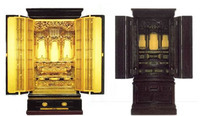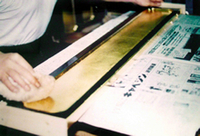

Total:131items
- Pottery & Porcelain (18)
- Lacquerware (4)
- Glasswork (2)
- Wood & Bamboo Work (19)
- Leather Work (1)
- Papermaking (13)
- Textile (20)
- Dyeing products (5)
- Masonry (1)
- Metal Work (11)
- Stationery (4)
- Livingware (3)
- Accessory (4)
- Toys & Entertainment (14)
- Interior (2)
- Other crafts (10)

 |
Main Production Site:Osaka |
 《Characteristics》
《Characteristics》The Shitennouji Temple, Osaka, West Japan, was established in 593 by Prince Shotoku Taishi, which is famous with a stone monument “Dainihon bukkyo saisho” meaning the Buddhism arrived here for the first time in Japan.
For building the temple, Shotoku invited Baekje artisans. They made the Kamimachi plateau as the famous Buddhist altar and article production area later. Osaka is proud of its tradition for producing altars and articles for 1400 years.
In the Edo period (17-19c), Osaka was one of the largest cities and economic center prosperous with merchant culture in Japan. It is likely that the Buddhist altars became more luxurious as the merchant class gained more wealth. Their gorgeous decoration indicates the excellent artisan technique that provides the prominence becoming the most distinguishing characteristic of Osaka altars.
Other remarkable techniques include makie (lacquer sprinkled with gold powder) for building up design patterns above the surface, nurie (painting) that adopts a unique polishing and ungen saisiki (rainbow coloring) that adopts a carving known as the Osaka ramma (transoms) .
[Traditional craft, officially designated (By the Minister of Economy, Trade and Industry)]
Information by: Osaka Religious Instruments Commercial and Industry Corporative
Translation by: Shione Furuta, reviewed by Eri Hara

| Materials | Woods, gold powder and lacquer |
|---|---|
| Crafting Processes | There are 2 types of butsudans, or Buddhist alters, made with different materials and processes as follows:
◎A. Urushi-nuri kinbutsudann (Lacquered and gilded altar) 1. Urushi nuri (Lacquer coating) First, artisans coat the wood surface with whetstone and chalk (made with shell) powders. Then, repeat 3 lacquering processes (shitanuri (base), nakanuri (foundation) and uwanuri (surface)) to finish. During these processes, they must wipe out the dust from the surface and keep woods under the properly moist condition. 2. Makie (Lacquer painting with gold powder) This technique provides the most distinguishing feature of Osaka altar: Artisans use the taka-makie technique to build up design patterns above the surface through a mixture of metal powder and lacquer without molding. 3. Coloring Artisans paint and gilt the wood surface. This process provides the magnificent finish and solemn beauty. 4. Kazari kanagu (metal ornaments) Artisans punch the pattern lines of copper or brass plates, which were cut in appropriate sizes with taganes (burins) in order to smooth their surface. Then they color plates with ao-sentoku (blue-green), a unique Osaka altar color. ◎B. Karaki meimoku bustudan (Foreign wood altars) 1. Woodworking Artisans cut and shape the naturally dried quality woods into appropriate size for each part. They shape hard woods with the specific plane and then miter with prepared joints and glue to frame. 2. Carving Artisans trace Buddhist patterns on the wood surface to carve with several styles from openwork, engraving to finishing. After carving, they polish the entire pieces with sand paper, color and set up woods inside altars. 3. Finishing Artisans color the polished and fixed wood surface of all parts using the traditional technique. Finally, they coat the lacquer over woods repeatedly for glazing. 4. Installation Artisans mount the altar with gilt, cover the slide door with silk gauze and embed assembled parts. Then install the slide door and paper panes inside the altar carefully adjusting each part: after then, check entirely. |
| History | It is said that Osaka is the oldest place of Buddhist altar production in Japan. In the historical record Nihon-shoki, when Buddhism was introduced to Japan in 552, King Wideok of Baekje sent 6 Buddhist sculptors and temple artisans (carpenters) with sutras to Ootsuura, Nambatsu (current Mitsu’ura-cho, Chuoh-ku, Osaka), where was one of pivotal points over the ocean.
When Prince Shotoku Taishi built the Shitennouji temple in 593, he gave permission to 4 Baekje artisans to settle at the Kamimachi plateau. It is said that those artisans from the Asian continent led the later Buddhist altar/fitting production in Osaka. Since the Edo period (17-19c), Osaka butsudan started to develop on a full-scale. Osaka is the place where Jodo-Shinshu (The True Essense of the Pure Land Teaching: the school of Pure Land Buddhism) was originated as we see in the founded mother temple, Ishiyama-Honganji. Due to the prevalence of danka (parishioner) and shumon’ninbetsu aratamecho (the village people register of religious faith and relationship) systems, more demands for Butsudan created the opportunity for Osaka to grow as its production area gradually. In the 1800s, several butsudan manufacturing techniques emerged: kazari-naga, kazari-hira uchidashi (metal hammering/sinking) using metal tools, decorative metal fittings, gilding including hikari-oshi (burnishing), omo-oshi (pressing), kona-dome and roironuri (wet black lacquer) painting. For coloring, a new technique called ungen daishiki (rainbow coloring) that provides the graceful touch and a pattern-designing technique called taka-makie emerged. Taka-makie uses the relief raised with lacquer to prevent the rust damage from metals that resulted the three-dimensional appearance on designs like hammered metals. Artisans started to make the simple and small todana (shelf) butsudans with cedar, pine and cypress woods which believers could easily install on shelves. The production of compact-size butsudans with cedar, pine or cypress woods also started to meet the increasing demand. In the middle of Edo-period(18c), some artisan used imported wood called “karanoki (imported woods)” such as rosewood, ebony wood and quince. Having adopted the lacquering style technique and design, this unique altar became the main Osaka product as well as the lacquering style. |
| Related URL | http://osakabutsudan.com/ |
◆Exhibition / Showcase
Osaka Religious Instruments Commercial and Industry Corporation
Address: 355 Tai, Mihara-ku, Sakai-shi, Osaka-fu
Telephone: +81-72-363-2160 (Japanese only)
FAX: +81-72-363-2170
◆Event Information
Assistance needed? For inquiries in English:
JTCO Contact Form
Your inquiries will be forwarded by JTCO in Japanese to the organization you wish to contact.
*Please write the name of craft you wish to ask about.



